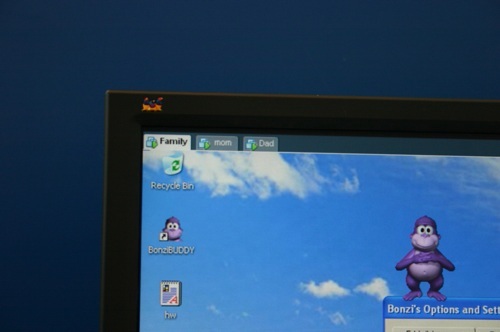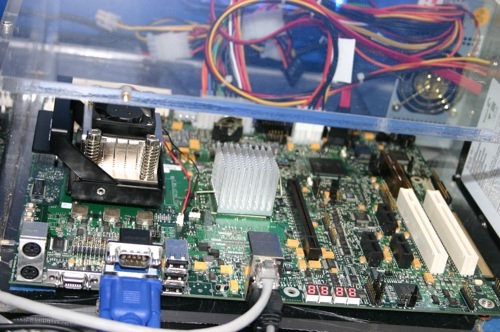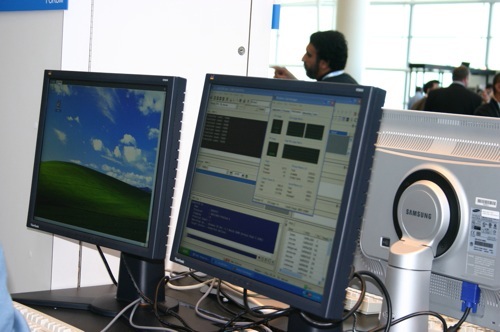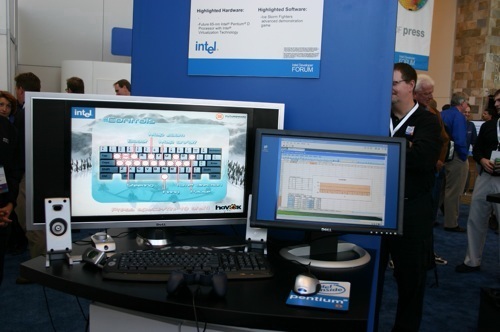Fall IDF 2005 - Day 1: Coverage of Everything
by Anand Lal Shimpi on August 24, 2005 2:31 AM EST- Posted in
- Trade Shows
Virtualization Everywhere
Intel had a relatively strong focus on virtualization technology at this year's Fall IDF:
All of the desktop virtualization demos were done on either 65nm Intel Presler processors (65nm Pentium D) or 65nm Yonah processors, both featuring Intel Virtualization Technology. Below we have a Dell Dimension PC featuring a 65nm Pentium D:
The 65nm Presler system also happened to be a BTX form factor PC.
Alongside the Presler demo systems, Intel had a 65nm Yonah demo platform:
Because it's too early to showcase Yonah notebook designs, all Yonah platforms were demonstrated in this open air fashion.
The virtualization demos were fairly run of the mill; they all used VMWare and mostly involved different virtual partitions for various users or tasks.
The demo below is of a 65nm Presler system acting as a development workstation, developing code on the right screen and testing the compiled program in various OSes each in their own virtual partition on the left screen.
This next demo featured two virtual partitions, one running business applications while the other is running a game:
Although there is a fair amount of hardware complexity in enabling virtualization, the software exposed to the user remains quite simple. Switching between virtual partitions is as easy as can be:
















14 Comments
View All Comments
jediknight - Wednesday, August 24, 2005 - link
What encryption algorithm does the Seagate drive use? And is it firmware-upgradeable?smn198 - Thursday, August 25, 2005 - link
I'd like moredetails on this. If you've got an OS installed and no key yet, could you then add a key and have it re-encrypt the data or would you need to pull the disk out and do this from another system? Shame Seagate won't ship software. Is there anything free?missleman - Wednesday, August 24, 2005 - link
BONZI BUDDY?!?!?! WTF? I cant beleive intel was stupid enough to install that on their computers.JarredWalton - Wednesday, August 24, 2005 - link
Maybe it was a demonstration of malware getting installed on one virtual OS, and then another OS could detect it and remove it? I know Intel has talked about using virtualization for virus-related stuff before, so it's not too much of a stretch.Hacp - Wednesday, August 24, 2005 - link
Also nice to see the Xbox360... I'm not gonna buy one.xsilver - Wednesday, August 24, 2005 - link
is amd moving to ddr2 and then m2 sockets in a 2 stage process?if so that's pretty evil -- makes users upgrade twice
JarredWalton - Wednesday, August 24, 2005 - link
No, M2 is DDR2 for desktops. S1 is DDR2 for the mobile sectore. F is for the server/workstation market. All are DDR2-only solutions, and there will be no DDR2 support without a socket transition.IamTHEsnake - Wednesday, August 24, 2005 - link
Mitosis looks promising indeed.It's technologies like this that intrigue me. This is more of what Intel should focus on, not just the brute computational strength of mhz or pipeline stages.
I am also looking forward to hearing more about die-stacking and DRAM-on-die.
Furen - Wednesday, August 24, 2005 - link
Yes, mitosis sounds nice indeed (though I'd expect it to be worthless on tasks like gaming), hopefully the software overhead wont be too bad by the time we start seeing it.phaxmohdem - Wednesday, August 24, 2005 - link
One has to wonder in Re: to Mitosis...They say that it is just started in Research and Development, and that we may not see if for 5-10 years..... By then wouldn't all apps be written to take advantage of multithreading? Thus rendering Mitosis a day late and a dollar short?